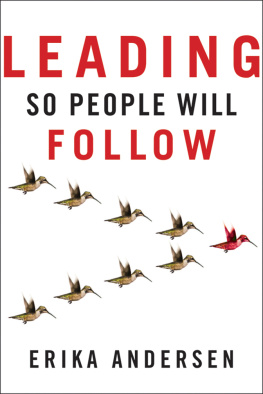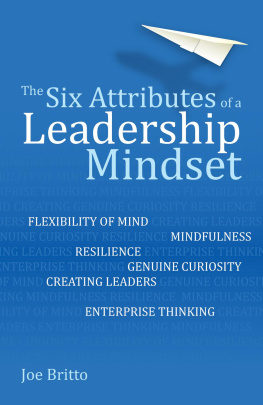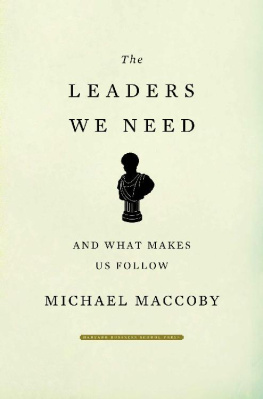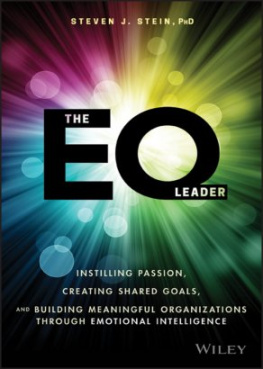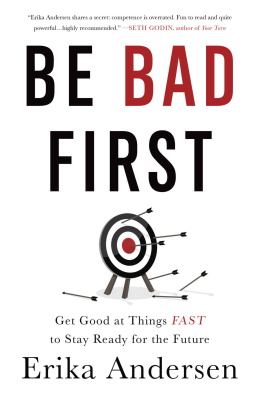
More Praise for Leading So People Will Follow
A fresh, approachable, and compelling guide for improving ones leadership profile. It is a very worthy read.
Douglas R. Conant, retired president and CEO, Campbell Soup Company; New York Times best-selling author of TouchPoints: Creating Powerful Leadership Connections in the Smallest of Moments
* * *
For over a decade Ive worked with Erika and her colleagues, and theyve consistently helped us get ready and stay ready for the future. In Leading So People Will Follow , she gives all leaders the tools to craft a desired future in their own lives and work.
Benita Fitzgerald Mosley, chief of sport performance, USA Track & Field
* * *
In Leading So People Will Follow , Erika has captured much of what has made our work with her so valuable over the years. She answers the complex question of what it takes to lead well, in an engaging, practical, and inspiring way.
Dawn Ostroff, president, Cond Nast Entertainment Group
Jacket design by Adrian Morgan
Author photo by Dion Ogust
Cover art Mike Truchon Shutterstock
Copyright 2012 by Erika Andersen. All rights reserved.
Published by Jossey-Bass
A Wiley Imprint
One Montgomery Street, Suite 1200, San Francisco, CA 94104-4594www.josseybass.com
No part of this publication may be reproduced, stored in a retrieval system, or transmitted in any form or by any means, electronic, mechanical, photocopying, recording, scanning, or otherwise, except as permitted under Section 107 or 108 of the 1976 United States Copyright Act, without either the prior written permission of the publisher, or authorization through payment of the appropriate per-copy fee to the Copyright Clearance Center, Inc., 222 Rosewood Drive, Danvers, MA 01923, 978-750-8400, fax 978-646-8600, or on the Web at www.copyright.com. Requests to the publisher for permission should be addressed to the Permissions Department, John Wiley & Sons, Inc., 111 River Street, Hoboken, NJ 07030, 201-748-6011, fax 201-748-6008, or online at www.wiley.com/go/permissions.
Limit of Liability/Disclaimer of Warranty: While the publisher and author have used their best efforts in preparing this book, they make no representations or warranties with respect to the accuracy or completeness of the contents of this book and specifically disclaim any implied warranties of merchantability or fitness for a particular purpose. No warranty may be created or extended by sales representatives or written sales materials. The advice and strategies contained herein may not be suitable for your situation. You should consult with a professional where appropriate. Neither the publisher nor author shall be liable for any loss of profit or any other commercial damages, including but not limited to special, incidental, consequential, or other damages. Readers should be aware that Internet Web sites offered as citations and/or sources for further information may have changed or disappeared between the time this was written and when it is read.
Jossey-Bass books and products are available through most bookstores. To contact Jossey-Bass directly call our Customer Care Department within the U.S. at 800-956-7739, outside the U.S. at 317-572-3986, or fax 317-572-4002.
Wiley publishes in a variety of print and electronic formats and by print-on-demand. Some material included with standard print versions of this book may not be included in e-books or in print-on-demand. If this book refers to media such as a CD or DVD that is not included in the version you purchased, you may download this material at http://booksupport.wiley.com. For more information about Wiley products, visit www.wiley.com.
Library of Congress Cataloging-in-Publication Data
Andersen, Erika.
Leading so people will follow / Erika Andersen. 1st ed.
p. cm.
Includes index.
ISBN 978-1-118-37987-5 (cloth); ISBN 978-1-118-43169-6 (ebk.); ISBN 978-1-118-43170-2 (ebk.); ISBN 978-1-118-43168-9 (ebk.)
1. Leadership. I. Title.
HD57.7.A524 2012
658.4'092dc23
2012027909
To my beloved bear and our FGL
ONE
The Longing for Good Leaders
We want good leaders. In fact, we crave good leaders. Were hungry for good, worthy, followable leaders in every part of our lives.
You can see it in our very public cynicism about and hanging-out-to-dry of all the leaders who fall short of our expectations. You can hear it in our hopeful, almost mythic, recounting of tales of those leaders we think/feel/believe just might be great.
We have a deeply wired-in need for leaders who will guide us well and safely; who care more about the success of the enterprise than about their own comfort; who call out our best and take full advantage of who we are. And we long to be that kind of leader as wellto evoke that Im with youlets go! response from those who work with and for us.
Ive come to believe that this longing for good leaders is an ancient, primal group survival mechanism. Until recently, if you chose badly in terms of who you decided to follow, you and your family and friends were likely to die: to starve to death, be overrun by invaders, fall into violent lawlessness. And although the stakes arent as high these days (generally), our wiring hasnt really changed.
This book offers a window into what those core timeless attributes are, why they are so essential to us, and, perhaps most important, how to develop these attributes in yourself. How to become the leader people will follow, so that together you can build strong teams and companies that will survive and thrive through the modern business version of famine and invasions.
So how did I crack the code?
In the mid-1990s, I was balancing two very important things (this may resonate for many of you): my family and my business. I had young children, and the consulting firm I had founded in 1990 was starting to take off. I spent most days observing and working with leaders in client companies and most evenings reading bedtime stories.
I started to notice something very interesting in my client organizations. Often the person who was the appointed leader was not the person others looked to for direction and reassurance. In one meeting this was so blatantly the case that I wondered that others didnt notice; the CEO would say something, and most of the folks attending the meeting would quickly glance at the CFO to note his reaction. They clearly, though perhaps unconsciously, were treating the CFO as their actual leader, even though the CEO was the official leader.
What is it , I started to wonder, that makes someone willing to consider one person his or her leader but not another?
At the same time, as I was reading story after story to my kids, I began to notice that many of the tales were about someone overcoming adversity to become a worthy leader. In fact, the more I read, the more I noticed a pattern: the poor lad (almost always a lad versus a lass, but well overlook that for the moment), generally the youngest and least impressive of three brothers, makes his way through a very specific and predictable series of trials. And in the process, he develops or reveals a core set of personal attributes that allow him to save the princess and become the wise and just ruler by the end of the tale.
Many of the stories my daughter and son loved best were from a series of books published in the early twentieth century that included fairy stories and folktales from all over the world. As I read them, I noticed that this pattern of attributes essential to becoming a leader was remarkably consistent across time and culture. It seemed to me that I had stumbled on an archetype. So as I read and continued to look for the common elements, I began to think about why this should be sowhy human beings would have a built-in archetype for the qualities to look for in a leader.
Next page
